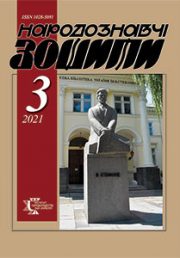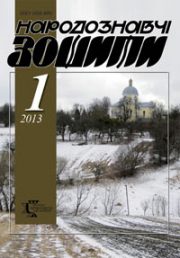The Ethnology Notebooks. 2019, 1 (145), 73—80
UDK 746.3.01(477.83-2Жовк.)”19/20″
DOI https://doi.org/10.15407/nz2019.01.073
KUTSYR Tetiana
ORCID ID: https://orcid.org/0000-0002-6522-0640
Junior Researcher
Ethnology Institute of National Academy of Sciences of Ukraine,
Folk Art Department,
15, Svoboda Avenue, Lviv, 79000, Ukraine
Contacts: e-mail: sonechko_29@ukr.net
Abstract. Nowadays the embroidery has remained the most accessible decoration clothing technique. Recent events have led to the search for new means of expression a national identity, in particular, in embroidery. In this context, there is lack of information about technical, compositional and coloristic features of embroidery in some Opillia folk art centers. The purpose of the article is to find out the characteristic features of Zhovkva folk embroidery as an Opillia embroidery center. The research methodology of this article is based on comparative-historical method and art-study analysis. They have allowed to most fully identify Zhovkva embroidery`s features during the specified period, have contributed to the analysis of it’s artistic peculiarities. Results, Conclusion. Zhovkva embroidery stands out by transparent ornaments embroidered by counted satin stitch, cross-stitch, stebnivka-stitch and zanyzuvannia-stitch (solid stitch). From color restraint 20—30`s in women`s and men`s shirts, aprons conceded to the colorfulness. Traditional in these areas black, red and blue were added blue, purple and yellow colors. The inherent embroidery of the XIXth century preserved a certain rarity of the ornaments, as well as the tradition of sewing around the joint of two parts with decorative sutures (hemstitch, stebnivka-stitch shtapivka-stitch, bavnytsia-seam). They were contributed to the unification of individual compositional elements into a single whole. Towels, bedspreads and tablecloths of the early XXth century are usually decorated with cross-stitchpatterns. From the middle of the XXth century Zhovkva embroidery has gradually lost the features characteristic of the previous period. Traditional ornaments were replaced by geometrical and flower patterns borrowed from printed circuits.
Keywords: Opillia, Zhovkva, embroidery, folk clothing, seam, ornament, coloration.
Received 6.02.2019
REFERENCES
Zakharchuk-Chuhai, R. Z. (1988). Ukrainska narodna vyshyvka (zakhidni oblasti Ukrainy). Kyiv: Naukova dumka [in Ukrainian].
Kara-Vasylieva, T.V. (2008). Istoriia ukrainskoi vyshyvky. Kyiv: Mystetstvo [in Ukrainian].
N.D., Manucharova, S.Y., Sydorovych, & I.F., Krasytska (Eds.) (1960). Ukrainske narodne mystetstvo. Tkanyny ta vyshyvka. Kyiv: Derzhavne vydavnytstvo obrazotvorchoho mystetstva i muzychnoi literatury URSR [in Ukrainian].
K.H., Huslystyi (Ed.) (1961). Ukrainske narodne mystetstvo. Vbrannia. Kyiv: Derzhavne vydavnytstvo obrazotvorchoho mystetstva i muzychnoi literatury URSR [in Ukrainian].
N.D., Manucharova (Ed.) (1956). Ukrainske narodne dekoratyvne mystetstvo. Dekoratyvni tkanyny. Kyiv: Derzhavne vydavnytstvo literatury z budivnytstva i arkhitektury URSR [in Ukrainian].
T., Kravchuk (Ed.) (1961). Ukrainski narodni vyshyvky. Lvivska oblast. Kyiv: Vydavnytstvo Akademii nauk Ukrainskoi RSR [in Ukrainian].
About the State Historical and Architectural Reserve in Zhovkva, Lviv region. Retrieved from: http://diaz-zhovkva.org.ua/diaz-u-m-zhovkvi/ (Last accessed: 30.10.2018) [in Ukrainian].
Aliieva-Honcharuk, A. Have a holiday for the soul… Retrieved from: http://vzhovkvi.com/kultura/vlashtujmo-svyato-dlya-dushi.html (Last accessed: 10.06.2018) [in Ukrainian].






